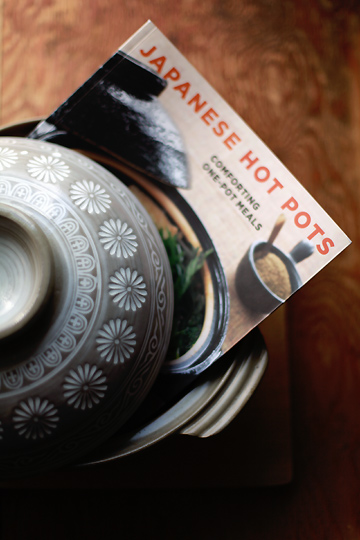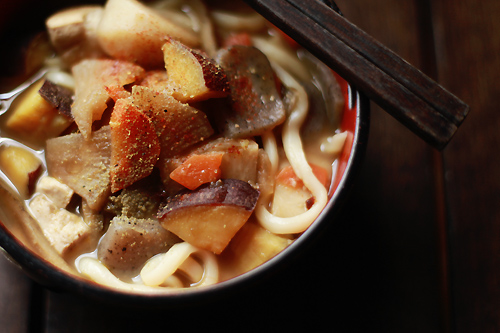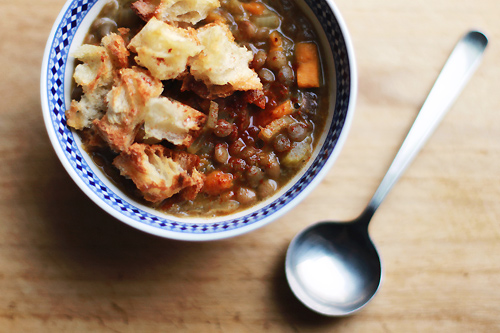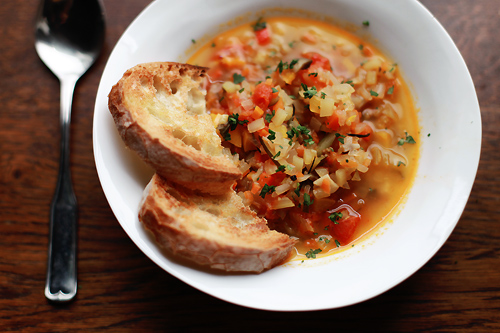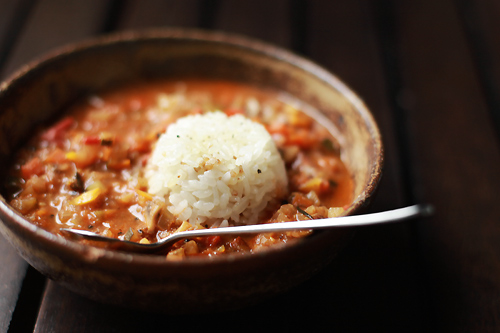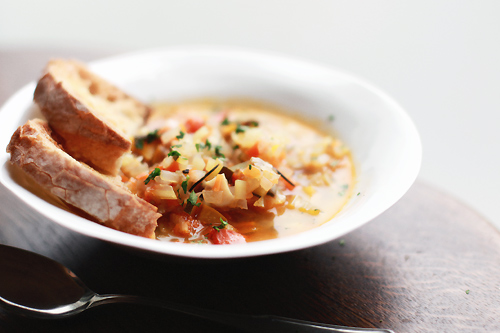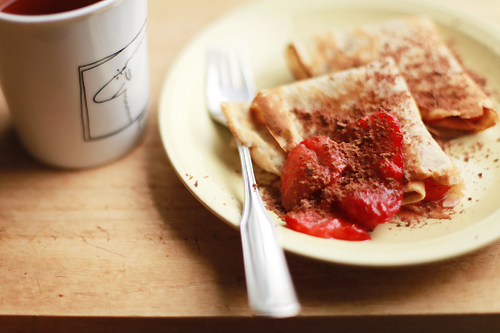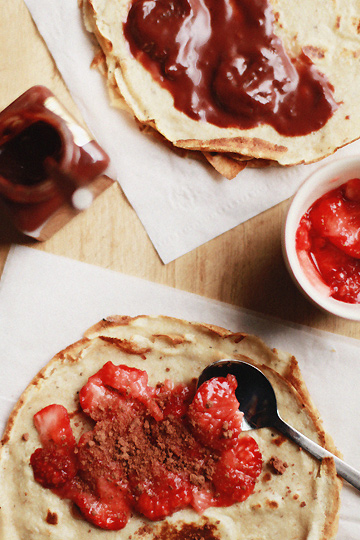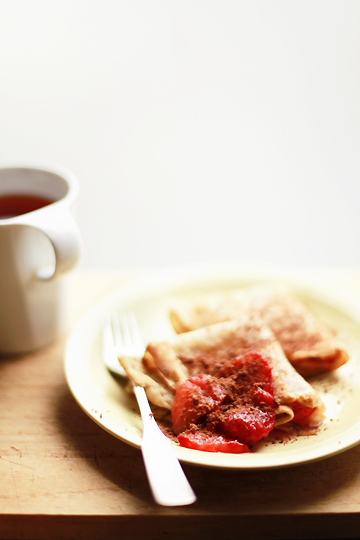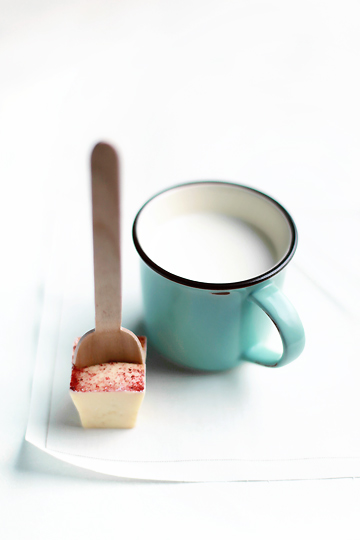Japanese winter comes with nabe. Or is it the other way around?
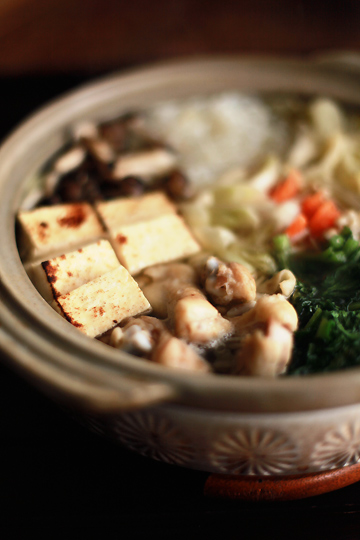
Sometime at the end of November or so, depending on where you live in Japan, you'd start hearing people speak of it, seeing signs at restaurants advertising it, and most likely thinking about it yourself as the cold wind forces you to hunch your shoulders and hurry your steps to home or wherever you are heading for. The magic word: nabe.
As a kid, on any given day during winter when my mother declared the day's dinner by saying "Ok, it's nabe today", it would never fail to receive an enthusiastic approval from the young girls that my sister and I were.
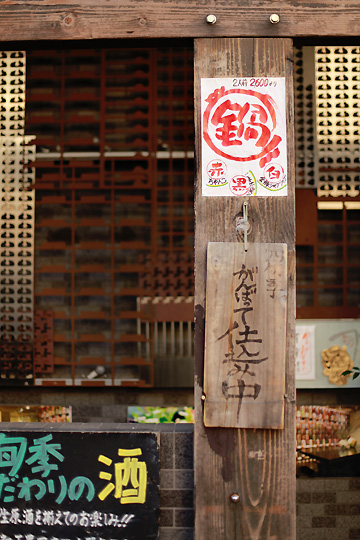
Grown up, when we plan dinner, a suggestion like "should we do nabe today?" would often settles everything - either eating at home or out somewhere.
It can be either cooked at home or served at a restaurant, and every household and eatery probably has their own nabe specialties, as well as some "regular" kinds that you find across the region, or even countrywide.
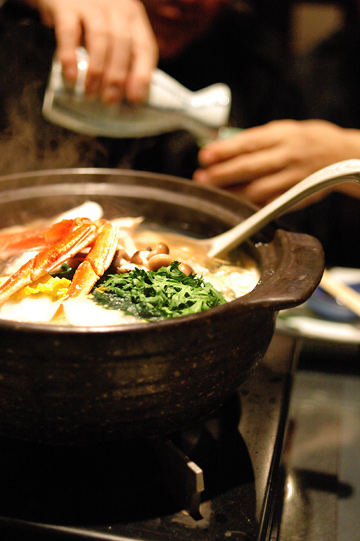
It often is a simple - humble, even - dish with whatever ingredients you can have thrown into the pot, but it can also make an exquisite meal with a selection of luxurious ingredients. All in all, we must be eating nabe at least once a week during the winter - or at least I do. Quite possibly more.
Nabe, or "hot pot", is Japan's favorite, ultimate winter comfort food in which you cook season's vegetables with or without seafood/fish or meat in a broth in a large pot, or nabe - often earthenware called donabe.
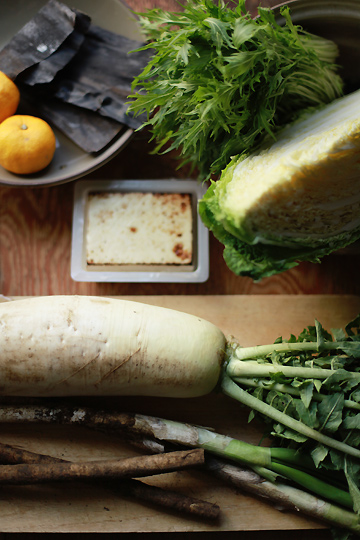
common ingredients of hot pots
Other than being tasty, it's usually quick to make (you cut up the ingredients and put everything in the pot - that's basically it); economical (use ingredients in season that come cheap); and most importantly, very filling and warming - by the time you are finished, you'll always feel steaming hot, with your stomach full. Always. There's something about hot pots that makes you eat yourself silly until you can barely move. Yes, every single time. After all these years eating hot pot dishes every winter, I don't seem to have learned lessons... who knows, that might be because of the magic, too.
So when you find yourself noticing the magic word here and there, you know the winter is here.
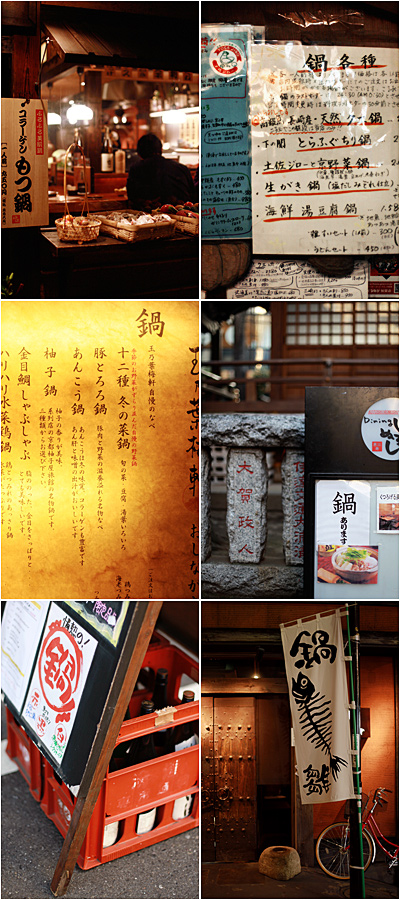
spotted it? the word nabe ("鍋" in kanji) seen on signs, banners, and menus at restaurants every corner of the town.
And hot pots stay around as long as the winter does, in all sort of forms: different kinds of vegetable/meat/seafood to use, different types of stocks/broths to cook them in, and different sauce/condiments to accompany it all with.
Regardless of ingredients/broths/condiments used, a hot pot is always served in a single pot for everyone at the table to share, although it is not necessarily one-pot cooking, for you may sometimes need to pre-cook your ingredients before they go into the serving pot.
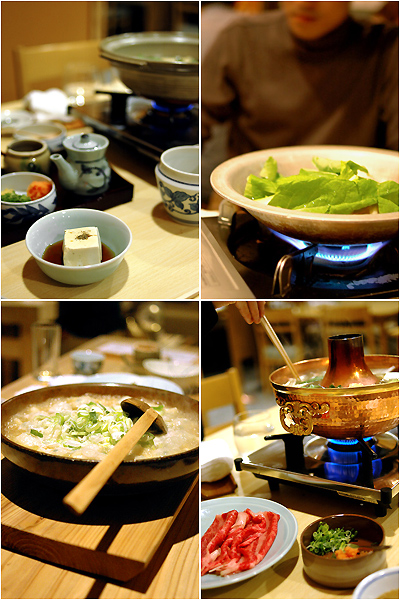
having a hot pot dinner with friends (clockwise from top left): yudofu; fish nabe; beef shabu-shabu; and gyoza nabe
But essentially it's a fuss-free dish, and the whole point I think is to eat what is in season in abundance, with (mostly) minimum trouble to prepare, especially when you are making it at home.
The most well-known Japanese hot pots outside the country must be sukiyaki and shabu-shabu. I can understand it, for beef is one very popular ingredient in the Western culture, making it more readily accepted by people who are not used to Japanese cuisine. While they no doubt make dinner to impress, though, there is so much more to nabe than these two beef dishes.
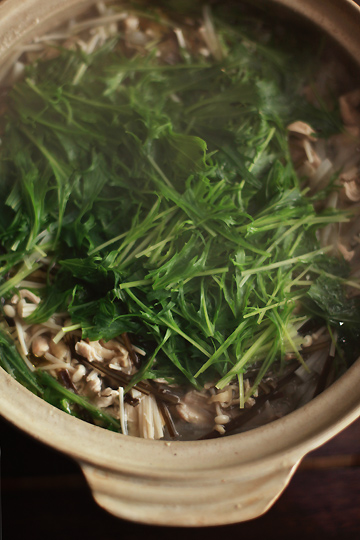
So I was glad when I heard last year that New York-based Japanese chef Tadashi Ono (restaurant Matsuri) and food journalist Harris Salat (blog the Japanese Food Report) were having a new cookbook devoted to nabe dishes for (mostly) North-American home cooks and beyond. And I was even more excited to receive a copy for myself, a life-long nabe eater and cook (only in the winter, but that's that).
The book, Japanese Hot Pots: Comforting One-Pot Meals (Tadashi Ono and Harris Salat, Ten Speed Press, 2009), was out last September, but I was away from home in my travels in Europe and then in Nagano, and didn't get to cook much anything until after coming back at the end of December. And let's face it: nabe is in essence a winter dish, so it was only fitting that I finally had some time to cook from the book as the month of January brought some cold air to us in Tokyo - a perfect time to do hot pots.
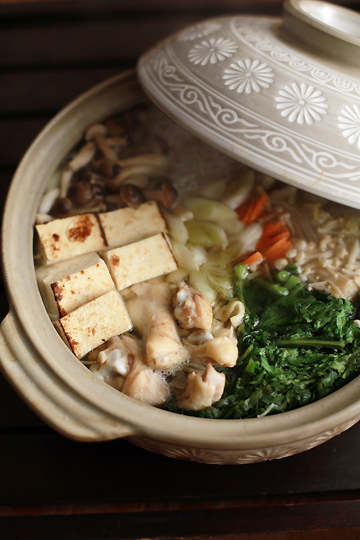
Now, one thing to note before start cooking; first, although I was excited to take a look at the book, it was because I was being more curious to see how the authors introduce their readers to this beloved food of Japan that is less represented overseas, than my being purely interested in finding out new recipes.
Though a very common dish, nabe was never something I'd look for recipes in cookbooks; I learned how to cook hot pots from my mother or aunt at home, or perhaps by seeing some "new" ones on food channels, or even trying some at a restaurant or friends' and reproducing them at home.
So I was pleasantly surprised to discover more - a lot more in the book.
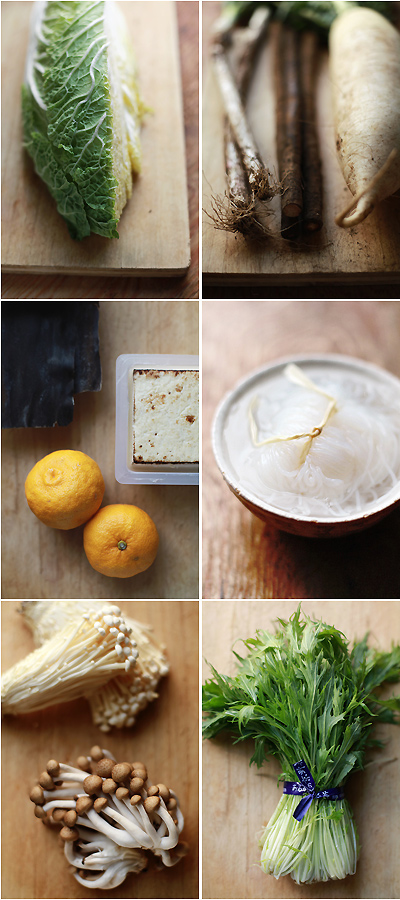
some of common ingredients of hot pots (from top left): hakusai (napa cabbage); negi spring onions, gobo (burdock root), and daikon radish; kombu, yaki-dofu (broiled tofu), and yuzu; shirataki noodles; enoki and shimeji mushrooms; and mizuna
Not only does the book feature some fifty hot pot recipes (many with photographs), it also devotes a large portion of it for profile of ingredients often used in hot pots, including some of winter vegetables that you may not be familiar with outside of Japan, such as gobo (burdock root) and mizuna greens.
I took a quick look at some of them a little while ago, but the book has more complete information you can turn to if you are cooking with Japanese winter vegetables, even for dishes other than hot pots, including how to choose them and how to cut/slice them.
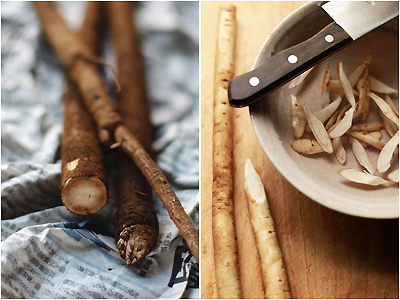
gobo, or burdock root, can literally look like root of a tree; scrubbed clean and cooked through, it renders a rustic, earthy flavor with a hint of sweetness
I was also happy to see there are more than a few paragraphs devoted to shime, or "the finish", for the reason that the authors sum up perfectly: "[t]o someone Japanese, a hot pot (...) doesn't seem complete without a serving of rice or noodles" and "Japanese often swear it's the best part of the meal". Well, exactly - sometimes I don't know if I am having shime because we did nabe, or doing nabe because I want to have shime.
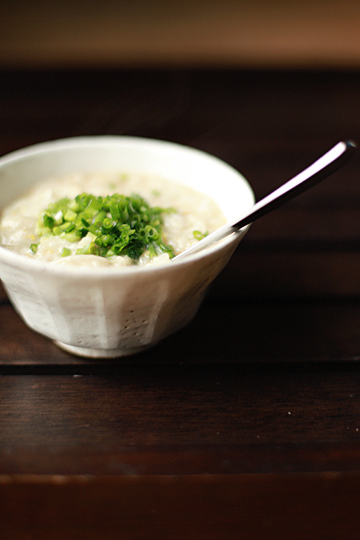
rice shime for breakfast on the following day, with an egg stirred in
Shime is a serving of rice or noodles added to the cooking liquid/broth that remains in the pot after most other ingredients have been eaten, which is practically the essence of the hot pot that has taken on all the flavors of the ingredients. The most common shime may be rice and noodles, especially udon - at least in Tokyo area; there seem to be regional differences across the country, and they may use other types of noodles in other areas.
Either way, there is no doubt that this addition of carbs gives the finishing blow to an already filling meal. But it is too good to pass up - there is no way to waste any of the broth, because it really is the best part.
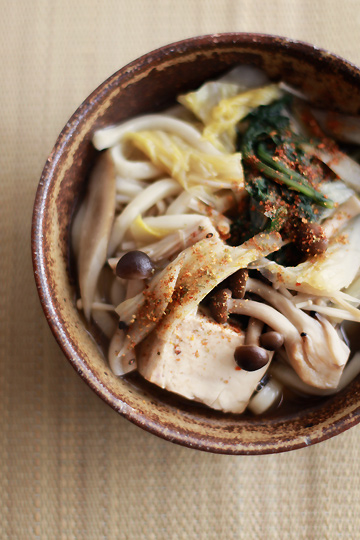
But even if you, like I tend to do these days, find it IMPOSSIBLE to eat anything after huge servings of the hot pot, you still don't want to chuck any of what's left in your pot; just do the shime next day! For the past month or two, leftover hot pots have made me a lot of delicious lunch, with either rice or noodles added to them.
And if you are being really keen, here's something I sometimes do: you can do both noodles and rice, though not at the same time. You'd probably like to start with noodles - my favorite is udon -, say, at the end of your nabe. After the noodles, you'd still have some broth left (if not, add some water or broth), which you can use to make zosui or ojiya (both rice-based shime), perhaps on the following day. Note that this works only in this order; first noodles, then rice, for the latter will absorb all the liquid in the pot (hence no broth left for noodles).

I should also note that I sometimes add noodles (again, mostly udon) to my hot pots from early on rather than at the end as shime, to make a hearty one-bowl meal.
Some other ways of shime even turn the whole thing into something with a completely different flavor - such as adding miso or Japanese curry. As for me, I rather like a hot-pot-turned-into-curry, especially as curry udon.
Now, as for the hot pot recipes - well, turns out there were more than a few that were new to me. Okay, I may be a life-long nabe eater, but this book has made me realize how big a variety hot pots can have, and that I may have eaten only the same few things over and over again, especially when I made them at home.
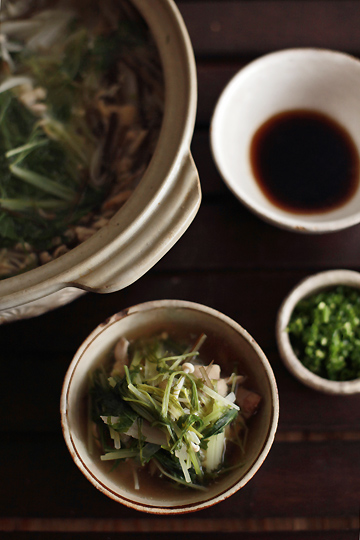
From nationwide favorites (Crab Hot Pot, Oden) to regional specialties (Akita Hunter Hot Pot, Hiroshima Oyster Hot Pot) and from traditional (Tofu Hot Pot, Old Tokyo Tuna Belly Hot Pot) to more contemporary (Chicken Curry Hot Pot, Pork Kimchi Hot Pot), a variety of hot pot recipes from around Japan (though many from the northern parts of the country, where the long and harsh winter requires more warm dishes) are categorized according to the main ingredients: vegetables and tofu; fish and other seafood; chicken and duck; and beef, pork, lamb, and venison.
You can pick one based on what you have/like, but you can also read the little stories that come with each of the hot pots and see what inspires you...
Now here are what I have tried from the book so far, both something new and something familiar - a few new ones first:
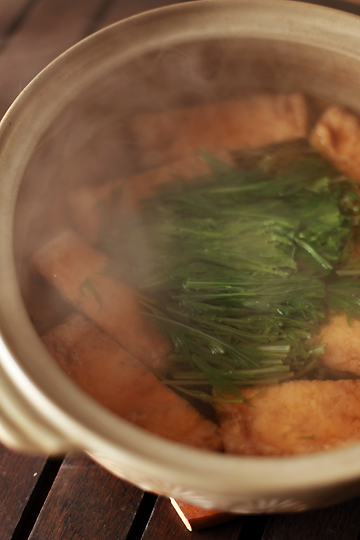
"Needle" Hot Pot (Hari Hari Nabe): a simple hot pot that highlights the fresh, crisp texture of mizuna, which the name hari-hari refers to. Paired with abura-age here, it can be put together in no time.
One minor change that I made to the recipe was that I put the mizuna right before removing the pot from heat, leaving the green barely cooked (the recipe tells you to cook it for five minutes); I like my mizuna as crisp as possible even in a warm dish, and it gets wilted almost as soon as it comes in contact with heat - so I try not to cook it too long. It will be wilted by the time of a second helping, but at least it will still be crisper for the first few minutes - so hurry up!
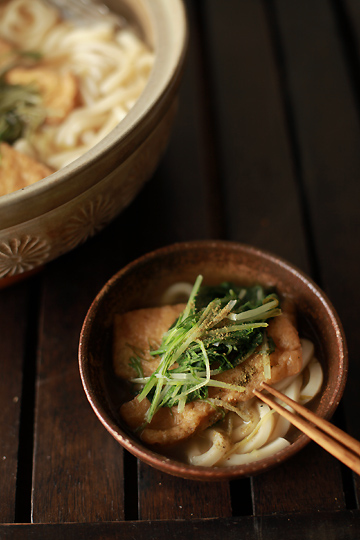
Here I put udon noodles in the pot early on. Yum! Paring abura-age and mizuna is what we do a lot, often in a form of salad - but they made a nice combo in hot pots, too.
+++
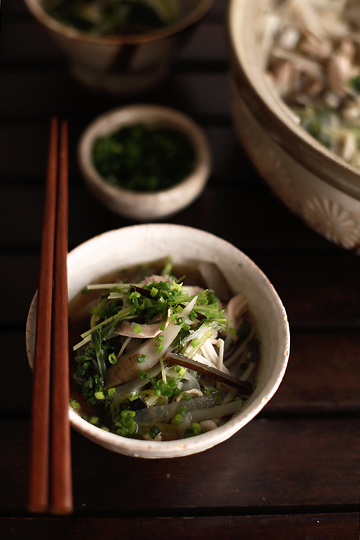 Old Tokyo Chicken Hot Pot (Moryo Nabe)
Old Tokyo Chicken Hot Pot (Moryo Nabe): although it has "Tokyo" in its name, this was the first time I've heard/read about this hot pot. I didn't even know what
moryo is, for that matter; according to the book, "
[m]oryo is a mythical creature, bipedal and exceedingly hairy", and the thinly sliced ingredients in the pot apparently reminded old Tokyo folks of this imaginary creature.
The namesake monster aside, the ingredients of the hot pot are all fairly common - chicken (first poached and shredded),
daikon, burdock root, and mizuna.
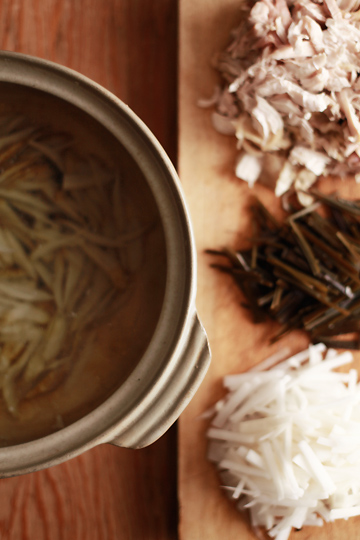
What I liked about this recipe is that after you make
dashi broth for the pot with
kombu, you cut up the seaweed and use it as an ingredient of the dish.
Kombu is packed with flavor and nutrients even after being used to make
dashi, so this is a great way to eat it if you have ever wondered what to do with it.
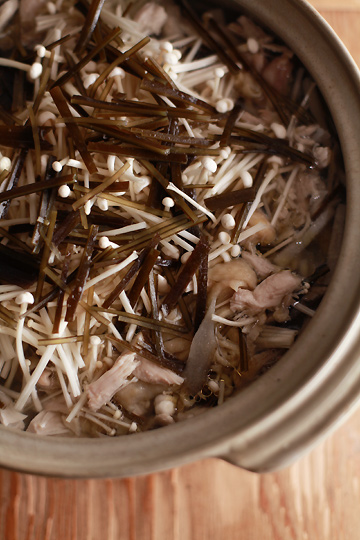
In the spirit of "everything matchstick thin", I added
enoki mushrooms for extra "hairiness" - and it didn't hurt at all!
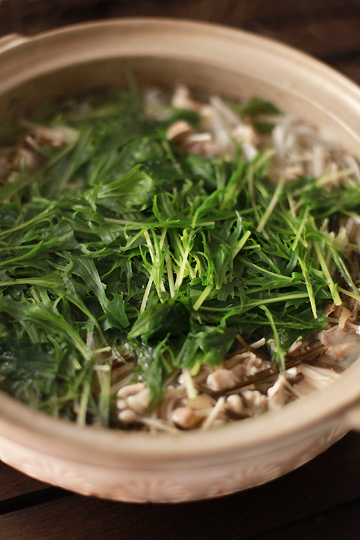
Again, I cooked mizuna for barely a minute - both stems and leaves.
The suggested
shime was soba (buckwheat) noodles, which I normally don't use in hot pots, for I don't like soba overcooked - which is part of the deal in hot pots (overcooked udon, meanwhile, is okay with me, as far as it is in a hot pot). This wasn't too bad here, but I'd have rice if I make this again.
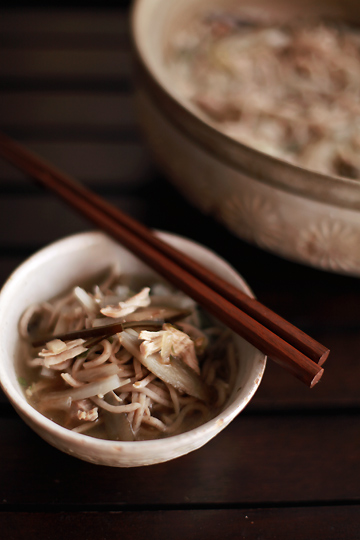
But really, is it just me or this messier look with soba noodles in it is somehow living up better to its name
moryo?
If you happen to be interested in what
moryo should look like, you can see a picture on wikipedia
here - not exactly appetite-inducing, but there you have it.
+++
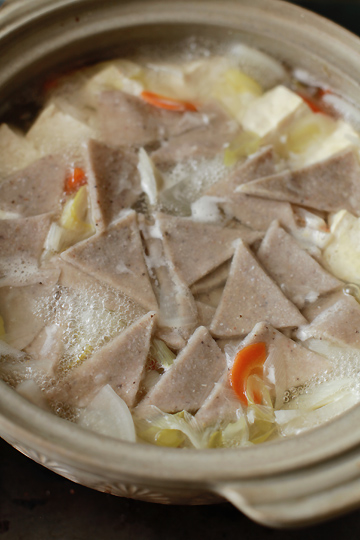 Rustic Soba Noodle Hot Pot (Soba Kakke Nabe)
Rustic Soba Noodle Hot Pot (Soba Kakke Nabe): speaking of using buckwheat in hot pots, this one uses it as its main ingredient, although not in a form of thin noodles like the one you'd be most familiar with. Here, you make thin triangles (
kakke, or "broken pieces") out of soba dough and cook them in a broth full of root vegetables, and serve it with miso dip mixed with garlic or
negi.
This one was another new dish to me, partly because it is from Northernmost part of Japan which I know little about. But it sounded good to me, so I decided to give it a try - including the soba
kakke making part.
Now I must mention that I have never made soba noodles from scratch, which is considered to be extremely tricky and require a lot of practice and skills. In fact, this was my first time making any form of soba other than in baking, so I wasn't too sure how it would turn out.
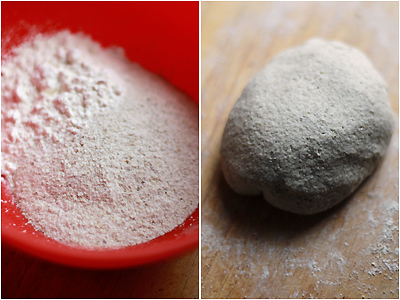 making a soba kakke dough
making a soba kakke dough
As it turned out, this was the only thing that didn't come out right from this cookbook; here you add boiling water to the mixture of buckwheat and all-purpose flours, and blend until a dough forms, then knead it for about five minutes until it feels elastic. Well, there was apparently too much water for my flours, and it was impossible to make the whole thing into a dough, let alone knead it, without adding more flours - a quite a lot of them.
Which I did, both buckwheat and all-purpose. Eventually though, I managed to make a dough good enough to be rolled out and cut into thin triangles.
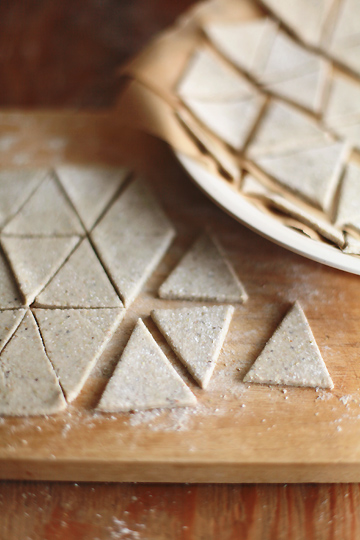
Once I had my triangles ready, the rest was bliss; they were cooked in a pot of broth with carrot, daikon, and burdock root slices and served with the miso dipping sauce blended with chopped
negi (the recipe's first choice is garlic, but negi works good, too).
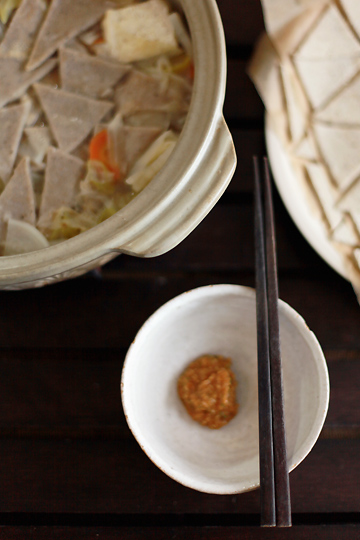
Also, the miso paste was supposed to be strong aka miso, though I just used regular miso that I normally stock, and it was still good.
While having fun trying hot pots that were new to me, I also couldn't help but doing those I've always been familiar with - or at least close to what I do a lot, like these ones...
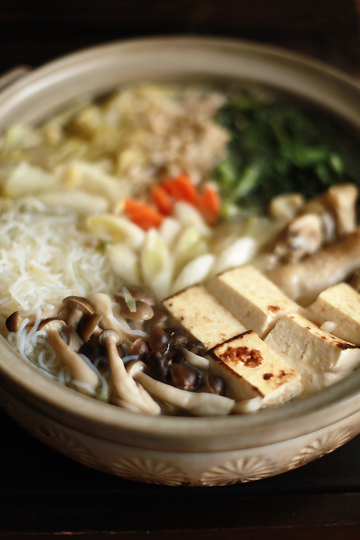 Hakata Chicken Hot Pot (Tori Mizutaki)
Hakata Chicken Hot Pot (Tori Mizutaki): originally from Hakata, a historical town now part of Fukuoka City on Japan's southwest island of Kyushu,
mizutaki is now enjoyed widely across the country, including our family.
In fact, this may well be a type of
nabe we did the most often in my family back when my sister and I were growing up; chicken, tofu, vegetables, and mushrooms all mingle well in a pot, making a delicious and nutritious meal.
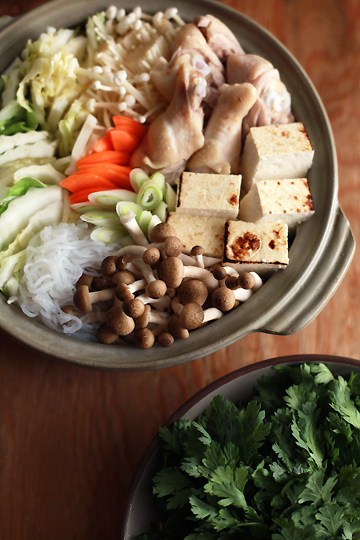 all ingredients (except for shungiku leaves, which is to be added later) nested neatly in the hot pot, before cooking; it might seem to be too much of them, but once cooked, greens will shrink and give more room for more to be added to...
all ingredients (except for shungiku leaves, which is to be added later) nested neatly in the hot pot, before cooking; it might seem to be too much of them, but once cooked, greens will shrink and give more room for more to be added to...
The recipe in book
Japanese Hot Pots is more or less the same as what we'd do at home, save for a few minor differences; the recipe uses regular cabbage as opposed to napa cabbage, which we'd always use. It also tells you to use skinned and boned chicken legs and thighs, while we'd often use chicken pieces with bones and skin left on for more flavors. Although, I understand that not everyone cares for bones and stuff, so that's up to you, I think.
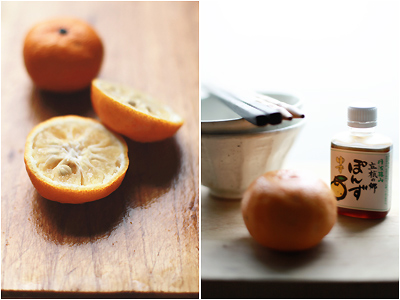 yuzu and ponzu shoyu are among the most popular seasonings for hot pots
yuzu and ponzu shoyu are among the most popular seasonings for hot pots
Another thing was the use of
yuzu kosho, a spicy condiment made of yuzu, chili pepper and salt that was also originated in Kyushu.
While
mizutaki was already a common dish in Tokyo area when I was a kid,
yuzu kosho wasn't; I don't remember seeing it anywhere in my local supermarkets, and we'd usually use
ponzu and soy sauce instead. And maybe a healthy dose of
shichimi togarashi on top, too.
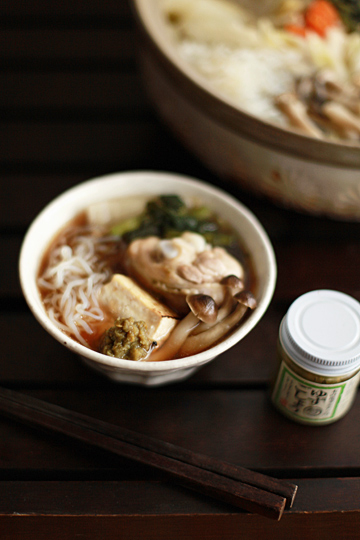 mizutaki served with a spoonful of yuzu kosho
mizutaki served with a spoonful of yuzu kosho
Some few decades later,
yuzu kosho (or
yuzu gosho, to be strict) has gained nationwide popularity, and readily available everywhere. The grown-up me loves it, too, and I now use it for my hot pots often. (I couldn't help but pour some soy sauce, too.)
+++
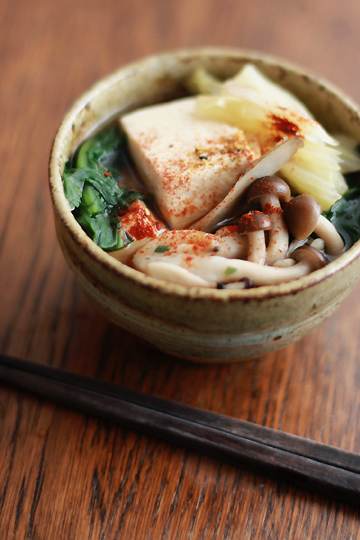 Mushroom Hot Pot (Kinoko Nabe)
Mushroom Hot Pot (Kinoko Nabe): to put it very simply, this is like
mizutaki but without chicken - and a lot of mushrooms. And oh, the broth here is seasoned with soy sauce, sake, etc. to cook the ingredients, while a
mizutaki broth is always cooked and served unseasoned, so that everyone individually seasons their bowl to taste.
Here I topped my bowl with a lot of
shichimi togarashi (I like to eat my
nabe spicy); when I think of it, I used to put
shichimi on every hot pot I had (and a lot of other things) until I discovered
yuzu kosho.
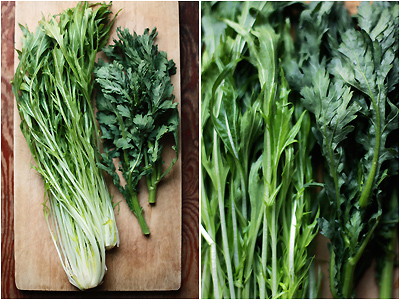 light-colored, stalky mizuna and dark-colored, leafy chrysanthemum-family shungiku
light-colored, stalky mizuna and dark-colored, leafy chrysanthemum-family shungiku
Likewise, we used to use
shungiku in pretty much any hot pot we'd make, along with napa cabbage - until we were introduced to
mizuna, which is originally from Kyoto and was back then not as common in Tokyo as it is now. Now I generally prefer the light and crisp
mizuna to the bitter and strong-tasting
shungiku, but for this
Kinoko Nabe I used the latter to highlight the hearty, robust flavor of the dish. (The recipe, by the way, uses spinach and not
shungiku - but I think it worked fine).
In any case, it's interesting to see how our long-time staple dishes have transformed over the years. And there are, of course, some things that never seem to change...
+++
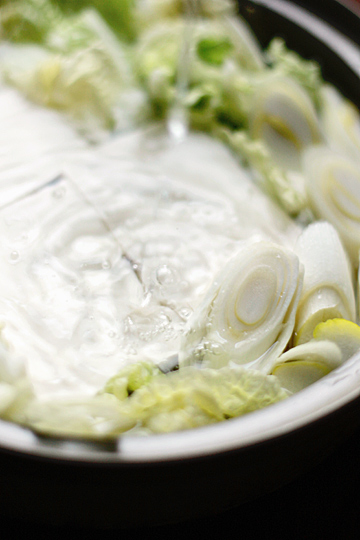 Tofu Hot Pot (Yudofu)
Tofu Hot Pot (Yudofu): perhaps the simplest hot pot around, this is, in its simplest form, basically warm tofu gently simmered in water. You can even heat tofu in microwave and call it
yudofu, but we'd often add napa cabbage and
negi.
This dish reminds me that, though often overlooked, I eat
nabe to savor the tongue-burning hot tofu and the sweet napa cabbage; an unadulterated delight.
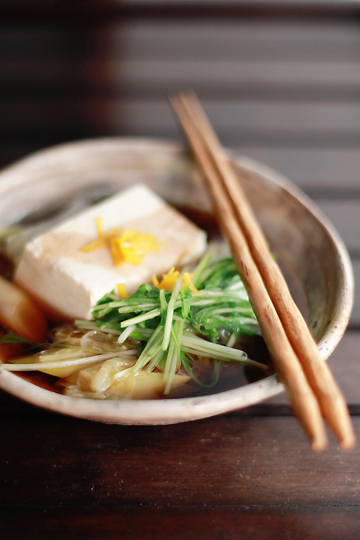
So here are what I have tried from the book over the past month and half or so, and there are more that I would love to try. One thing I should probably note: the list of what I made might give you an impression that the hot pot recipes of this book are overly vegetable-, mushroom-, and chicken-centered, but there are a good number of recipes for seafood- and fish-based hot pots, as well as those for beef and pork. I think I just tend to cook mostly with vegetables and chicken.
Other recipes I have not tried but would love to include Sea Bass Shabu Shabu, Bay Scallops and Sea Urchin Hot Pot, Duck and Duck Dumpling Hot Pot, and Sake Brewer Hot Pot.
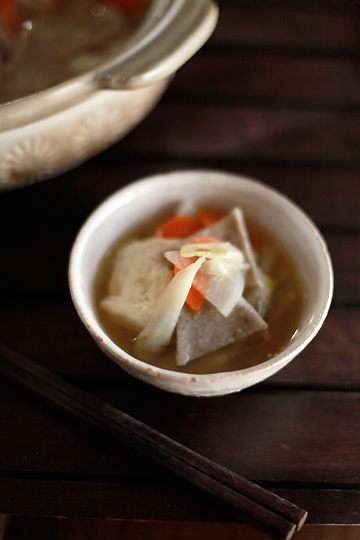
I'd also love to do another one of my favorite hot pots, too -
yuki nabe, or "snow hot pot". Also called
mizore nabe, or "sleet hot pot", it cooks ingredients in a heap of grated
daikon radish, which is where the name "snow" comes from. There are recipes for
yuki nabe abd
mizore nabe in the book, although my version is slightly different from either of the two; you can see what I usually do
here.
I hope I'll get to try one or two by the end of this winter; we are having some warm, springlike days over the past few weeks, but it still is the cold air that dominates. It will be a little while more until our
donabe is tucked away, and when it finally is, we know it's spring. Japanese winter indeed comes and goes with
nabe.
